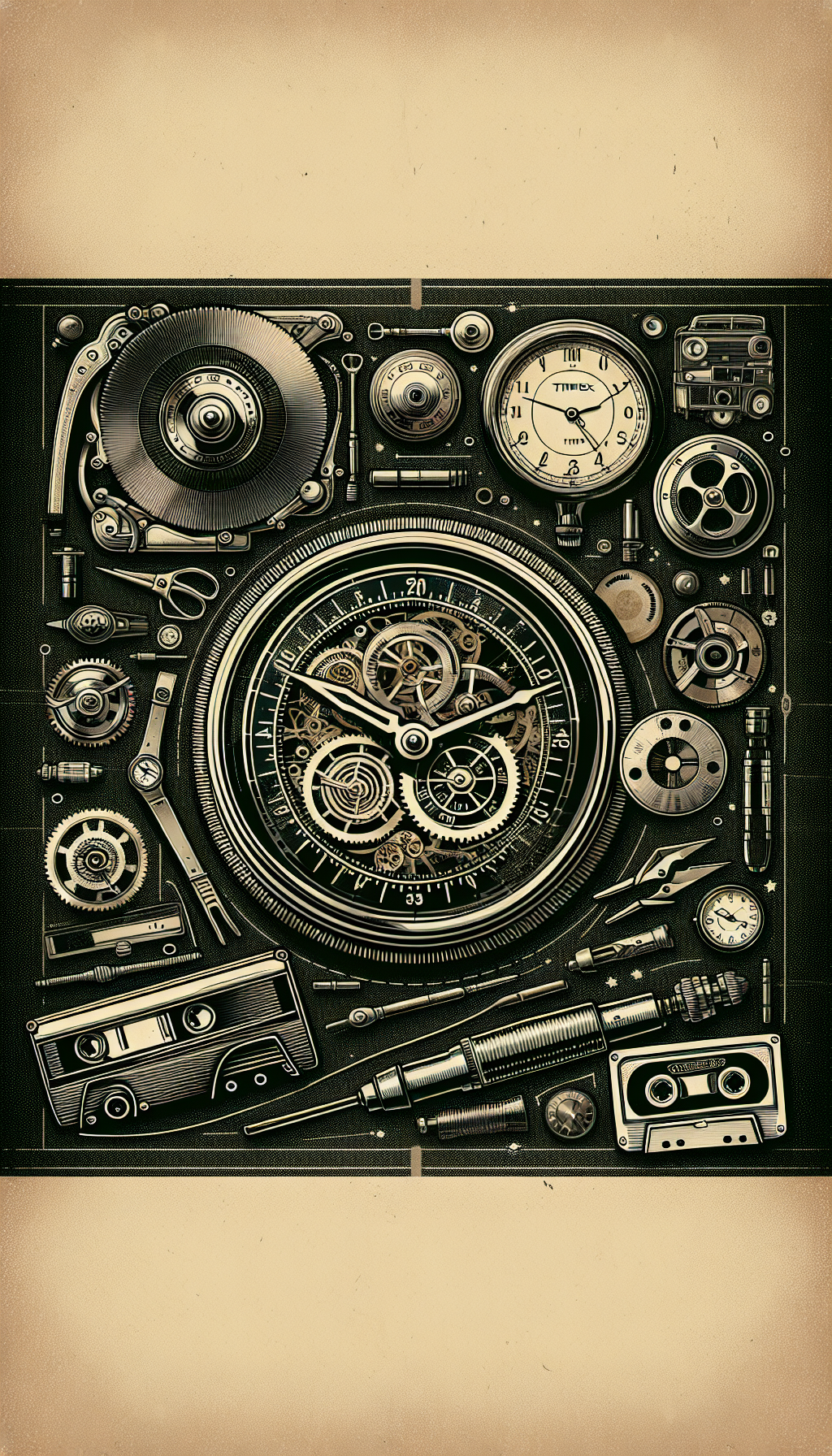Unlocking The Worth Discover The Hidden Value Of Vintage Timex Watches
Timex is often dismissed as “everyman” timekeeping—reliable, affordable, ubiquitous. That reputation is precisely why appraisers can overlook profit and scholarship buried in a tray of old Timex watches. With distinct model lines, a clear dating system, and an active collector base, vintage Timex pieces reward careful identification and condition analysis. This guide focuses on how to spot value, avoid costly restoration traps, and price with confidence.
Why Vintage Timex Watches Deserve Serious Appraisal
- Cultural significance: From the “Takes a licking and keeps on ticking” torture-test campaigns of the 1950s to the quartz upheaval of the late 1970s, Timex sits at the center of several watchmaking revolutions.
- Breadth of output: Timex produced a vast catalog—dress watches, divers-style, field/camper, character tie-ins, electrics, automatics. That variety creates pockets of rarity and demand.
- Collectible crossovers: Designers and pop-culture collaborations (notably Peanuts/Snoopy) bring non-watch buyers into the market, buoying values.
- Wearable sizes: Many Timex models measure 33–36 mm—small by modern tastes, but increasingly appreciated, especially when the design or dial color pops.
- Low fake risk, high mix-and-match risk: Outright counterfeits are uncommon; “franken” watches assembled from donor parts are not. Originality checking pays.
Bottom line: While common, lower-tier Timex models can trade under $50, distinctive references in clean, original shape can achieve several hundred dollars, with top-tier examples exceeding that in the right condition.
How To Identify And Date A Vintage Timex
A quick, structured triage transforms a nondescript Timex into a specific, dateable, and comp-ready object.
- Branding timeline:
- U.S. Time Company (post-WWII through the 1960s): Earlier dials and case backs may read “U.S. Time” or “Timex” by U.S. Time.
- Timex Corporation (from 1969 onward): Case backs typically marked “Timex Corp.” or simply “Timex.”
- Country of manufacture: Timex produced in the USA, Great Britain (notably Dundee, Scotland), West Germany, and later Asia. “Made in Great Britain” or “Made in USA” often points to 1950s–1970s; late 1970s–1980s sees more international assembly.
- Date codes:
- Many 1960s–1970s Timex dials have a two-digit year at 6 o’clock, tucked just inside the minute track (e.g., “67,” “73”). Check with a loupe.
- Case backs often carry a reference or production code that, matched to known charts, yields a production year. If no dial code is visible, use case back marks and movement type to bracket the era.
- Movement families:
- Mechanical pin-lever movements: Common calibers include M24, M25, M29 (hand-wind); automatic variants exist under “Viscount” and others. Pin-lever construction is robust but considered non-luxury.
- Electric (early battery-assisted, 1960s): Labeled “Electric” on the dial; uses a battery to power a balance wheel rather than a quartz oscillator.
- Quartz (late 1970s onward): Often marked “Quartz” or “Q Timex” on the dial; sweeping changes in design and case construction accompany quartz adoption.
- Model names to note:
- Marlin (hand-wind dress/field; waterproof-marked variants)
- Viscount (automatic)
- Electric (1960s hybrid tech)
- Q Timex (quartz era, including diver-style “Pepsi” bezel models from circa 1979)
- Sprite, Mercury (smaller or entry dress pieces)
- Character watches (e.g., Peanuts/Snoopy; check licensing marks on dial)
Photograph the dial (including 6 o’clock), case back, crown, and side profile; note bracelet or strap type and any signed hardware. These details are vital for comparison against known references and for detecting replaced parts.
Notable Lines And What They’re Worth
Values vary with originality, condition, and completeness. The ranges below reflect typical collector-market outcomes for clean, honest examples; exceptional pieces can exceed them.
- Marlin (1950s–1970s, hand-wind):
- What appraisers look for: Stainless steel cases (less common than chrome-plated brass), sharp case lines, original water-resistance text, unpolished backs, crisp dials (especially black or uncommon colors).
- Typical value: Chrome-plated, running, clean dial: $60–$150. Stainless examples or standout dials: $120–$250+.
- Viscount (automatic):
- Indicators: “Automatic” on dial; day/date variants command a small premium; some unusual dial textures or colors attract interest.
- Typical value: $80–$200; rarer variants higher.
- Electric (1960s):
- Why it matters: Early battery-assisted technology—historically interesting but more finicky to service than standard mechanicals.
- Typical value: $70–$180 when running and tidy; non-runners discounted heavily.
- Q Timex (late 1970s–1980s quartz):
- Flagship: Diver-style models with a rotating “Pepsi” bezel and woven bracelet (late 1970s origins). Original bracelet, bezel insert, and dial font matter.
- Typical value: Broadly $80–$250 for standard Q Timex; diver-style “Pepsi” can bring $200–$600 depending on originality, condition, and bracelet.
- Character watches (1960s–1970s):
- Standouts: Timex-branded Peanuts/Snoopy models, space-race themed dials, and clean, bright cartoon art with intact lume.
- Typical value: $150–$400 for clean, running examples; boxed or new-old-stock can exceed these ranges.
- Field/Camper and military-style:
- Cues: Matte dials, Arabic numerals, simple cases; originality of hands and lume is crucial.
- Typical value: $80–$200, with early/clean examples and period-correct straps at a premium.
- Dress gold-tone:
- Chrome or gold-plated brass cases with simple dials are abundant; plating wear often caps value.
- Typical value: $30–$90 running; non-runners usually parts value unless pristine.
Completeness adds lift: Original boxes, tags, instructions, retailer stickers, and especially signed bracelets or buckles can increase value 20–50% for desirable models.
Condition, Originality, And Service Considerations
Value is driven as much by what has not been done to a Timex as by what has.
- Cases and materials:
- Chrome-plated brass: The most common. Edge and lug wear, brassing, and plating loss are typical; these are difficult to correct invisibly. Heavy brassing suppresses value.
- Stainless steel: Scarcer; commands a premium. Check for magnet reaction and back stamps; stainless backs are more common than full stainless cases—distinguish the two.
- Dials and hands:
- Original vs. redial: Timex printing is crisp and consistent; fuzzy minute tracks, off-tone logos, or mismatched patina on hands vs. indices suggest a refinish or parts mixing.
- Lume: Pre-mid-1960s may use radium on some models; later typically tritium (often indicated by a “T” on the dial). Uneven or crumbling lume is common; avoid aggressive reluming unless historically correct.
- Crystals:
- Acrylic crystals scratch easily but can be polished; replacements are readily available and not value-damaging if the profile matches.
- Movements and service:
- Pin-lever movements were designed for low-cost production; many watchmakers won’t service them, but specialists can. Donor movements are often the practical repair route.
- Electric models require correct battery type and careful isolation of mechanical vs. electrical faults; expect higher servicing hurdles.
- Quartz: Battery corrosion and coil damage are the usual failure points; replacement donor modules may be the only viable fix.
- Water ingress:
- Vintage Timex cases are not reliably water-resistant by modern standards. Hazy dials, oxidation on hands, and rust near the stem are red flags. Treat seals as spent.
- Parts-swapping:
- Timex case families share dimensions; mixing of hands, dials, and crowns is common in the hobby. Verify font families, hand lengths, and case/dial period correctness.
A safe rule for appraisers: prioritize originality and cosmetic integrity over functionality; a clean, original non-runner may be worth more than a shiny, over-polished runner with mismatched parts.
Pricing Benchmarks And Market Signals
- Scarcity vs. demand:
- Demand concentrates around specific aesthetics (e.g., black-dial Marlins, diver-style Q Timex, crisp character dials). Plain dress watches are plentiful and require standout condition to rise.
- Size matters:
- Watches 35–36 mm attract broader modern interest than sub-34 mm pieces. A desirable model in a larger case size can command a notable premium.
- Bracelet and hardware:
- Original Timex-signed woven or folded-link bracelets, especially on Q Timex divers, can add substantial value. Period-correct straps with signed buckles are a plus on Marlins and field watches.
- Provenance and ephemera:
- Retailer-stamped boxes, warranty booklets, hangtags with model codes, and receipts streamline comps and support stronger pricing.
- Running vs. not running:
- For common models, running status can double value. For scarce variants, originality trumps; price conservatively if service history is unknown.
Suggested appraisal approach:
- Build comps by reference features (model line, case material, dial color, bracelet) rather than by “Timex” as a generic category.
- Adjust for originality (add premium) or visible plating wear/parts mixing (apply discount).
- For unserviced watches, disclose “running but not tested for accuracy or water resistance” and price accordingly.
Quick Appraisal Checklist
Use this 8-step checklist to triage a tray of Timex watches quickly and consistently:
- Identify the line: Note dial text (Marlin, Viscount, Electric, Quartz/Q Timex) and any character/branding.
- Date it: Loupe the 6 o’clock minute track for a two-digit year; cross-check case back branding (U.S. Time vs. Timex Corp.) and “Made in …” stamp.
- Case material: Determine stainless vs. plated. Look for “Stainless Steel” vs. “Stainless Back” and inspect lugs/edges for brassing.
- Size: Measure diameter excluding crown; note anything 35 mm+ as potentially more marketable.
- Dial and hands: Assess originality. Look for consistent patina, correct hand lengths, and crisp printing. Photograph close-ups.
- Bracelet/strap: Is it Timex-signed and period-correct? Keep original hardware with the watch.
- Function check: Light wind for mechanical (stop if resistance spikes), set time/date, test quickset if present; for battery watches, inspect for corrosion before attempting power.
- Value tiering: Slot into bands (e.g., $30–$90 common dress; $60–$150 clean Marlin; $80–$200 Viscount/Camper; $150–$400 character; $200–$600 Q diver) and annotate condition adjustments.
FAQ
Q: Are vintage Timex watches really “non-serviceable”? A: Many were designed for low-cost manufacture with friction-fit parts, so traditional jewelers often declined repairs. However, specialists do service them, and donor movements can provide parts. Appraise with the assumption that complex repairs may not be economical on common models.
Q: How can I tell if my Timex is stainless steel or plated? A: Read the case back. “Stainless Steel” typically means the whole case; “Stainless Back” usually means a plated brass case with a steel back. Visual brassing at high-contact points (lug tips, case edges) signals plating.
Q: What’s the safest way to test a mechanical Timex? A: Gently wind 10–15 half-turns and observe. If you feel gritty or abrupt resistance, stop. Check balance motion and minute hand travel. Do not immerse or ultrasonic-clean assembled cases; seals are aged and moisture ingress is common.
Q: Should I worry about radioactive lume? A: Some 1950s–early 1960s watches may use radium; later pieces typically use tritium. If in doubt, store away from prolonged skin contact, avoid scraping old lume, and consult a radiation detector for peace of mind.
Q: What details add the most value quickly? A: Original, crisp dial; stainless case; correct signed bracelet or buckle; clear date code; and documented box/papers. For Q Timex divers, the original woven bracelet and intact bezel insert are key.
By applying a structured identification method, focusing on originality, and using model-specific comps, you can move a vintage Timex from an overlooked drawer find to a cataloged, confidently priced collectible.




